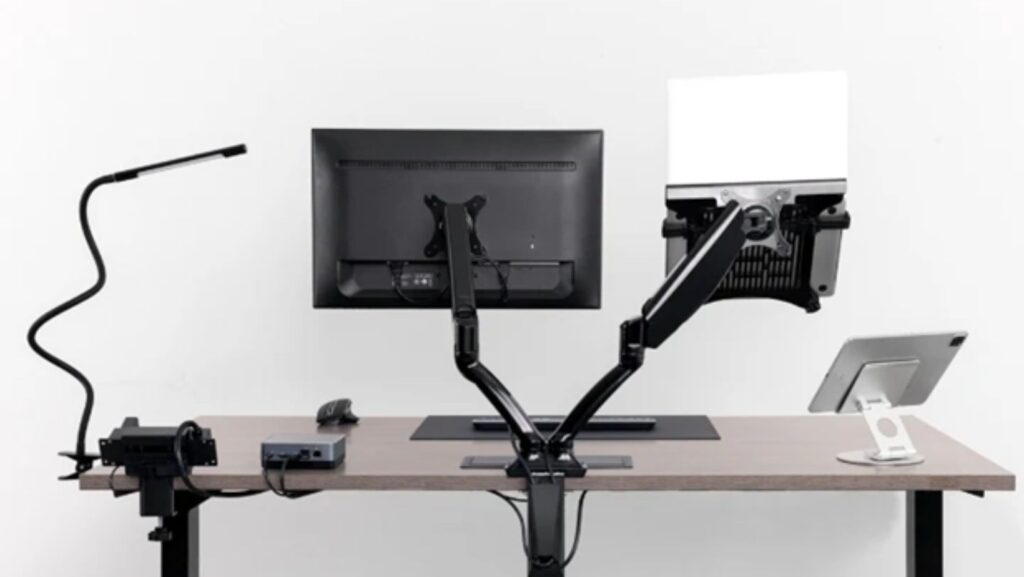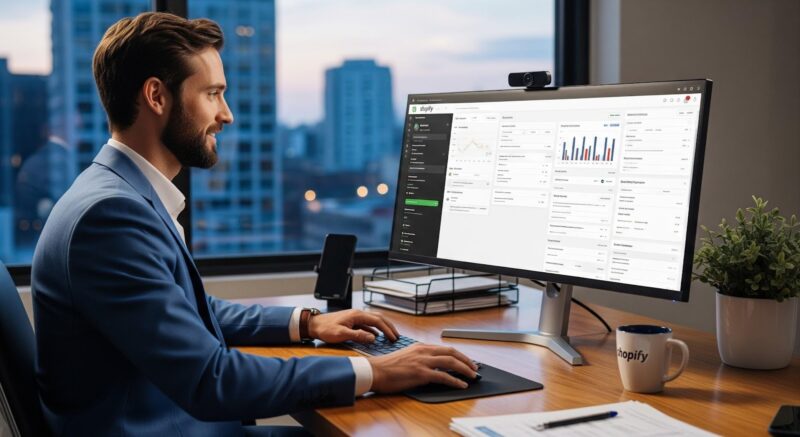
Does your workday leave you feeling like a prisoner hunched over a tiny desk, staring at a screen that seems miles away? Neck pain, eye strain, and discomfort are signs that your current screen setup does you more harm than good. Getting a monitor mount will allow you to take control of your work environment.
A monitor mount, also known as a monitor mounting bracket or monitor mount stand, is a game-changer for any computer setup. Allowing you to adjust the height, tilt, and swivel of your screen empowers you to create a setup catering to your specific preferences. Explore the many ways a monitor mount can revolutionize your workspace.
Benefits of Using a Monitor Mount
Here are the key advantages of a screen bracket:
Improved Ergonomics
A screen mount adjusts the display to eye level and a comfortable viewing distance, promoting better neck and back alignment. It translates to reduced pain, discomfort, and potential long-term health issues.
Increased Desk Space
Free up valuable desk real estate by elevating your monitor off the surface with a monitor mount stand. This creates a more organized workspace, allowing you to spread out your equipment with ease.
Enhanced Viewing Experience
A screen bracket positions your screen at the optimal viewing angle. It reduces eye strain and fatigue, allowing you to focus more effectively on your tasks.
Reduced Neck and Eye Strain
With this device, you can eliminate awkward neck angles and reduce eye strain.
Types of Display Mounts
The world of ergonomic devices offers many options to suit different workspace configurations:
#1. Desk Mounted Monitor Mounts
These popular monitor arms attach securely to the edge of your desk:

· Advantages: Easy installation, free up floor space, and a wide range of adjustability options available.
· How to choose: Consider the weight capacity of your screen, desired level of adjustability (height, tilt, swivel), and clamp style (C-clamp or bolt-through).
#2. Wall-Mounted Monitor Brackets
It is ideal for limited desk space or creating a standing desk setup.
· Benefits: Frees up desk space entirely, promotes better posture for standing desks, and often offers a wider range of motion.
· Considerations: Requires drilling into the wall may not be suitable for all wall materials; ensure your wall studs can support the weight of the monitor and mounting mechanism.
#3. Standalone Monitor Arms
These solutions are ideal for sit-stand desks or workstations lacking a dedicated mounting surface:
· Advantages: Offers a freestanding option, suitable for setups without available desk edges, and provides stability.
· How to choose: Consider the weight and size of your displays, desired level of stability, and adjustability options.
#4. Dual and Triple Screen Brackets
For users managing multiple screens, these devices are vital:
· Benefits: Enhances productivity by accommodating multiple monitors, optimizes desk space utilization, and facilitates ergonomic viewing angles.
· Considerations: Ensure compatibility with screen sizes and weights and assess the degree of adjustability needed for optimal viewing comfort.
How to Choose a Monitor Mount
Here is what you should know before shopping for this device:
Monitor Size and Weight Capacity
Ensure the monitor mount you choose can accommodate the weight and size of your display. Check the specifications of both the mount and your screen to ensure compatibility.
Adjustability
Consider the level of adjustability you need. Do you require a simple tilt adjustment, or do you want advanced features like portrait and landscape orientation? Choose a mount that offers the range of motion to suit your preferences.
Installation Options
Think about where you want to put your screen. Consider your workspace layout and choose an option with a compatible installation method.
Cable Management
Look for options with integrated cable management features to keep your cables organized and out of sight. It involves built-in channels within the mount arms or clips that attach to the back of the monitor stand.
Material and Build Quality
Consider brackets constructed from high-quality materials like steel or aluminum for durability and stability. Avoid flimsy plastic options that may not support the weight of your monitor or offer smooth adjustments.
Warranty and Customer Support
Look for offers with a solid warranty and readily available customer support in case you encounter any issues with installation or functionality.
How to Install a Monitor Arm
Installing a screen stand is easy, but the exact steps may vary depending on the model. Here are some tips to help you:

Step 1: Gather Necessary Tools
Most screen arms come with the necessary tools for installation. However, it is a good idea to have a Phillips screwdriver and a level on hand, just in case.
Step 2: Choose the Right Location
For desk-mounted options, ensure the chosen location on your desk has enough clearance for the clamp or base of the mount. For wall-mounted units, locate the wall studs using a stud finder to ensure secure installation.
Step 3: Attach the Mount to the Desk or Wall
Follow the manufacturer’s instructions, secure the clamp or base of the mount to the desk or wall using the provided screws.
Step 4: Mount the Monitor
Most monitor arms utilize a VESA mount plate attachment system. It involves attaching the VESA plate to the back of your screen using the appropriate screws and then sliding it onto the monitor mount arm. Tighten the locking mechanism to secure the device in place.
Tips for Optimizing Your Screen Setup
Here are some additional tips to maximize its benefits:
· The ideal screen height should position the top of the screen slightly below eye level. It promotes a neutral neck posture and reduces strain.
· Maintain a comfortable arm’s length distance between your eyes and the screen. It varies depending on individual preferences (a general guideline is 20 to 28 inches).
· For added versatility, consider screen arms that offer versatile adjustments. It allows you to switch between sitting and standing positions throughout the workday, further promoting good posture and comfort.
Transform your workspace. Choose a monitor mount for comfort, productivity, and a healthier you. Take control of your screen setup today and invest in your well-being for years to come!










